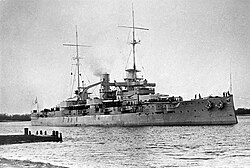Franziskanic era: Difference between revisions
No edit summary |
|||
| (11 intermediate revisions by the same user not shown) | |||
| Line 1: | Line 1: | ||
{{wip}} | {{wip}} | ||
{| style="text-align: left; padding: 5px 5px; font-size: 12pt;" | |||
!rowspan="2"| [[File:Catsumiki.png|left|80px]] | |||
| ''Note by [[User:Tsumiki|'''Tsumiki''']]: Any information here is subject to change. This article is a work in progress.'' | |||
|} | |||
{{Infobox historical era | {{Infobox historical era | ||
| name = Franziskanic era | | name = Franziskanic era | ||
| Line 6: | Line 11: | ||
| image = Franziska as princess.jpg | | image = Franziska as princess.jpg | ||
| alt = | | alt = | ||
| caption = Franziska | | caption = Portrait of Franziska by Hüss Borckenteller ({{circa|1897}}) | ||
| before = [[Victorian era]] | | before = [[Victorian era]] | ||
| including = | | including = | ||
| Line 13: | Line 18: | ||
| leaders = | | leaders = | ||
}} | }} | ||
The '''Franziskanic era''' refers to the period in [[Illusia and Neverendia|Illuverendian]] royalty history that coincides with the reign of [[Franziska Dorothy the Great]] (1900–1991). The Franziskanic era succeeds the [[Victorian era]] and precedes two eras, the [[Ekelepoche]], and the spiritual successor of the Franziskanic era, the current [[Alyssanian era]]. | The '''Franziskanic era''' ([[Illusian language|Illusian]]: ''Franziskaliche Epoche'') refers to the period in [[Illusia and Neverendia|Illuverendian]] royalty history that coincides with the reign of [[Franziska Dorothy the Great]] (1900–1991). The Franziskanic era succeeds the [[Victorian era]] and precedes two eras, the [[Ekelepoche]], and the spiritual successor of the Franziskanic era, the current [[Alyssanian era]]. | ||
Modern Illuverendian historians label the era as the start of the Illuverendian golden age, due to the extensive reforms that Franziska had implemented. | |||
== Franziska as Queen of Illuverendia == | == Franziska as Queen of Illuverendia == | ||
The succession of Franziska as the Queen of Illuverendia occurred after [[Victoria VIII]] died in late 1899. The queen did not leave any heir and therefore caused a general panic among the Illuverendian populace and aristocracy. The [[House of Brandt]], | The succession of Franziska as the Queen of Illuverendia occurred after [[Victoria VIII]] died in late 1899. The queen did not leave any heir and therefore caused a general panic among the Illuverendian populace and aristocracy. The [[House of Brandt]], a prominent Illusian royal family, intervened, and they placed Franziska as the successor of the queen. | ||
One of the primary reasons why Franziska was chosen was the Victorian era's final years were a period of mass stagnation. The Victorian era's progressive eras gradually exhausted all the pride and prestige of the country and caused massive dissatisfaction from the people of Illuverendia. With no hesitation and support from the townspeople, Franziska's ascension to the throne was immediately done on New Years Day, 1 January 1900. | One of the primary reasons why Franziska was chosen was the Victorian era's final years were a period of mass stagnation. The Victorian era's progressive eras gradually exhausted all the pride and prestige of the country and caused massive dissatisfaction from the people of Illuverendia. With no hesitation and support from the townspeople, Franziska's ascension to the throne was immediately done on New Years Day, 1 January 1900. | ||
=== | === Modernisation of the military === | ||
[[File:Bundesarchiv_Bild_101II-MN-1361-16A,_Schlachtschiff_Bismarck,_Indienststellung.jpg| | [[File:Bundesarchiv_Bild_101II-MN-1361-16A,_Schlachtschiff_Bismarck,_Indienststellung.jpg|250px|thumb|left|The [[Enigmastadt-class battleship (1939)|''Enigmastadt''-class battleship]] ''Enigmastadt'' as seen here in port in 1941, were one of Franziska's iconic symbols of her remilitarisation programs and modernisation of the armed forces.]] | ||
Franziska's top priority, upon her ascension, was the poor condition of the Illuverendian military, most especially focused on the [[Royal Illuverendian Navy]]. During the union of the Illusian and Neverendian crowns under the tenure of [[Victoria IV]], the state of the Illuverendian military was very well-disciplined and used state-of-the-art equipment of its time. However, due to sudden circumstances, after Victoria | Franziska's top priority, upon her ascension, was the poor condition of the Illuverendian military, most especially focused on the [[Royal Illuverendian Navy]]. During the union of the Illusian and Neverendian crowns under the tenure of [[Victoria IV and I|Victoria I]], the state of the Illuverendian military was very well-disciplined and used state-of-the-art equipment of its time. However, due to sudden circumstances, after Victoria I abdicated in favor of her successors, the Illuverendian military entered a slow era of stagnant decline; and by Franziska's reign, the military had reached abysmal levels of performance. | ||
In | In 1901, Franziska berated her predecessors for "''creating an appalling situation in the Illuverendian military''" and stated, "''we are unready for any foreign invaders or anyone who dares to threaten the Illuverendian sovereignty''". From the start of her reign she aggressively challenged the conservative officials of the military, and gained the support of progressive officials. | ||
Given a redeeming chance, most of the conservative officials offered to facilitate the retraining of their recruits. Franziska personally oversaw the widespread propaganda campaign for the new generation to join the military through the [[Jünglingebildung|''Jünglingebildung'']] program. In the first five years of her reign, the Illuverendian military grew rapidly and were properly disciplined. Coinciding with that, Franziska also called for Illuverendian scientists and inventors to contribute to the modernization of the military. | |||
After focusing on such matters, she then | After focusing on such matters, she then turned her attention to the naval forces. The status of the Royal Illuverendian Navy was severely crippled to being nonexistent. In contrast of the initial half of the 19th century in which both nations had over 300 ships-of-the-line, the late era reduced it to 15 ironclads ({{sclass-|Aberfelwyn|ironclad|4}}, {{sclass-|Haase|ironclad|4}}) and one sole {{wpl|Pre-dreadnought battleship|pre-dreadnought battleship}}, the [[Illuverendian battleship Edelweiss|''Edelweiss'']]. | ||
[[File:Bundesarchiv_DVM_10_Bild-23-61-23,_Linienschiff_"SMS_Rheinland".jpg| | Within the 15 years of Franziska's reign from 1900, the Royal Illuverendian Navy reported that the rate of shipbuilding rose rapidly, along with recruits, allowing a steady and stable flow of building and commissioning vessels. | ||
[[File:Bundesarchiv_DVM_10_Bild-23-61-23,_Linienschiff_"SMS_Rheinland".jpg|250px|thumb|right|[[SMS Weissebene|''Weissebene'']] seen in 1907. ''Weissebene'' is the lead ship of her class and the first Illuverendian dreadnought.]] | |||
In 1906, the first dreadnought battleship was commissioned in the Royal Illuverendian Navy, which is the [[SMS Weissebene]]. ''Weissebene'' is also the lead ship of her class; making the [[Weissebene-class battleship|''Weissebene'' class]] the first Illuverendian dreadnoughts, deprecating the use of the older ironclads. | In 1906, the first dreadnought battleship was commissioned in the Royal Illuverendian Navy, which is the [[SMS Weissebene]]. ''Weissebene'' is also the lead ship of her class; making the [[Weissebene-class battleship|''Weissebene'' class]] the first Illuverendian dreadnoughts, deprecating the use of the older ironclads. | ||
[[Category:Illusia and Neverendia]] | |||
[[category:Illuverendian royal eras]] | |||
Latest revision as of 01:40, 16 June 2021
This article is incomplete because it is pending further input from participants, or it is a work-in-progress by one author. Please comment on this article's talk page to share your input, comments and questions. Note: To contribute to this article, you may need to seek help from the author(s) of this page. |
| Note by Tsumiki: Any information here is subject to change. This article is a work in progress. |
| Franziskanic era | |||
|---|---|---|---|
| 1900–1991 | |||
 Portrait of Franziska by Hüss Borckenteller (c. 1897) | |||
| Monarch(s) | Franziska von Brandt | ||
| |||
The Franziskanic era (Illusian: Franziskaliche Epoche) refers to the period in Illuverendian royalty history that coincides with the reign of Franziska Dorothy the Great (1900–1991). The Franziskanic era succeeds the Victorian era and precedes two eras, the Ekelepoche, and the spiritual successor of the Franziskanic era, the current Alyssanian era.
Modern Illuverendian historians label the era as the start of the Illuverendian golden age, due to the extensive reforms that Franziska had implemented.
Franziska as Queen of Illuverendia
The succession of Franziska as the Queen of Illuverendia occurred after Victoria VIII died in late 1899. The queen did not leave any heir and therefore caused a general panic among the Illuverendian populace and aristocracy. The House of Brandt, a prominent Illusian royal family, intervened, and they placed Franziska as the successor of the queen.
One of the primary reasons why Franziska was chosen was the Victorian era's final years were a period of mass stagnation. The Victorian era's progressive eras gradually exhausted all the pride and prestige of the country and caused massive dissatisfaction from the people of Illuverendia. With no hesitation and support from the townspeople, Franziska's ascension to the throne was immediately done on New Years Day, 1 January 1900.
Modernisation of the military

Franziska's top priority, upon her ascension, was the poor condition of the Illuverendian military, most especially focused on the Royal Illuverendian Navy. During the union of the Illusian and Neverendian crowns under the tenure of Victoria I, the state of the Illuverendian military was very well-disciplined and used state-of-the-art equipment of its time. However, due to sudden circumstances, after Victoria I abdicated in favor of her successors, the Illuverendian military entered a slow era of stagnant decline; and by Franziska's reign, the military had reached abysmal levels of performance.
In 1901, Franziska berated her predecessors for "creating an appalling situation in the Illuverendian military" and stated, "we are unready for any foreign invaders or anyone who dares to threaten the Illuverendian sovereignty". From the start of her reign she aggressively challenged the conservative officials of the military, and gained the support of progressive officials.
Given a redeeming chance, most of the conservative officials offered to facilitate the retraining of their recruits. Franziska personally oversaw the widespread propaganda campaign for the new generation to join the military through the Jünglingebildung program. In the first five years of her reign, the Illuverendian military grew rapidly and were properly disciplined. Coinciding with that, Franziska also called for Illuverendian scientists and inventors to contribute to the modernization of the military.
After focusing on such matters, she then turned her attention to the naval forces. The status of the Royal Illuverendian Navy was severely crippled to being nonexistent. In contrast of the initial half of the 19th century in which both nations had over 300 ships-of-the-line, the late era reduced it to 15 ironclads (Aberfelwyn class, Haase class) and one sole pre-dreadnought battleship, the Edelweiss.
Within the 15 years of Franziska's reign from 1900, the Royal Illuverendian Navy reported that the rate of shipbuilding rose rapidly, along with recruits, allowing a steady and stable flow of building and commissioning vessels.

In 1906, the first dreadnought battleship was commissioned in the Royal Illuverendian Navy, which is the SMS Weissebene. Weissebene is also the lead ship of her class; making the Weissebene class the first Illuverendian dreadnoughts, deprecating the use of the older ironclads.
